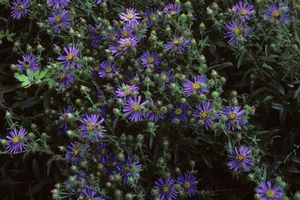New Moon Nurseries
Aster spectabilis
Showy aster
Native to North America
FIRST IMPRESSIONS: Aster spectabilis is an upright clump forming perennial with narrowly oval leaves. In late summer clouds of large violet daisies are clustered at the tip of each stem. Plants prosper in hot sunny sites with sandy soils.
HABITAT & HARDINESS: The range of Aster spectabilis extends along the Atlantic Coastal Plain from Massachusetts to North Carolina where it turns southwest to the Piedmont in South Carolina, Georgia and northeast Alabama. This species is considered to be rare in some parts of its range.
This aster occurs primarily in sandy soils at the edges of dry oak-pine woods, in pine barrens near the shore, along the sandy banks of ponds and creeks, in clearings or fields and along roadsides.
Plants are hardy from USDA Zones 4-8.
PLANT DESCRIPTION: Aster spectabilis is a softly sprawling perennial that forms small colonies from underground rhizomes.
Arching stems are covered with sticky hairs. The stems are mostly unbranched except toward the tip.
Leaves are oval, lance shaped or spoon shaped. Basal leaves have short winged leaf stalks and upper leaves are tiny and sessile. Leaf color often turns burgundy in fall and winter.
Flat topped branched flower clusters appear from late summer until mid-fall. The individual flower heads are large – up to 2”. Each head consists of a ring of about 30 blue to purple ray flower that surrounds a central cluster of yellow disc flowers. The blooms are showy and are produced for a long time in late summer and fall.
Flower heads are frequented by bees and butterflies.
Plants grow 1-2’ tall with 2’ spread.
CULTURAL & MAINTENANCE NEEDS: Aster spectabilis is extremely tolerant of drought and sun. Plants are pest resistant and somewhat unpalatable to deer and rabbits.
Plants form small colonies from underground rhizomes but are not aggressive.
LANDSCAPE USES: This is a good choice for a Wildlife Garden, Green Roof or Seaside Location. Plants are also used as Butterfly Nectar Plants or as part of a Grouping or Mass Planting. Aster spectabilis has Showy Blooms and can be used in Cottage Gardens, Deer Resistant Plantings, Dry Meadows, Water-wise Landscapes, Low Maintenance Plantings, Perennial Borders, Roadsides and Restoration Projects.
COMPANION & UNDERSTUDY PLANTS: Try pairing Aster spectabilis with Chrysopsis mariana, Coreopsis lanceolata, Rudbeckia hirta, Solidago odora, Carex pennsylvanica and Schizachyrium scoparium.
Aster divaricaus has similar height and flower appearance and could be substituted in a site with some shade.
TRIVIA: Many of the established Latin names of Aster spp. were changed recently due to DNA and genetic research findings. So Aster spectabilis is now known as Eurybia spectabilis.
Aster spectabilis received high ratings in a 2006 evaluation of “Asters for the Mid-Atlantic Region” at Mt. Cuba Center near Wilmington, Delaware. This species was praised for its large flowers, long bloom period, attractive foliage, pest resistance and ease of culture.
One of the best identification characteristics for Aster spectabilis is the appearance of the phyllaries or green leafy bracts beneath the flower. The bracts are spread or extend outward and are glandular and sticky to the touch.
Height:
1-2 ftSpread:
2 ftSpacing:
3-4 ftUSDA Hardiness Zone:
4-8Bloom Color:
VioletAster spectabilis Characteristics
Attributes
- Clay Soil
- Naturalizing
- Long Blooming
- East-Coast Native
- Drought Tolerant
- Dried Flower
- Cut Flower
Exposure
- Partial Shade to Full Sun
Flowering Months
- October
- September
- August
Foliage Color
- Green
Juglans nigra Tolerance (Black Walnut)
- Yes
Salt Tolerance
- Medium
Season of Interest (Foliage)
- Spring
- Fall
- Summer
Soil Moisture Preference
- Dry to Moist
Interesting Notes:
AKA Eurybia spectabilis
For more information on this plant, visit the USDA PLANTS Database:http://plants.usda.gov/java/profile?symbol=EUSP3
